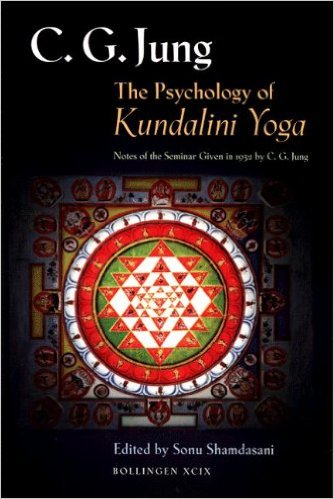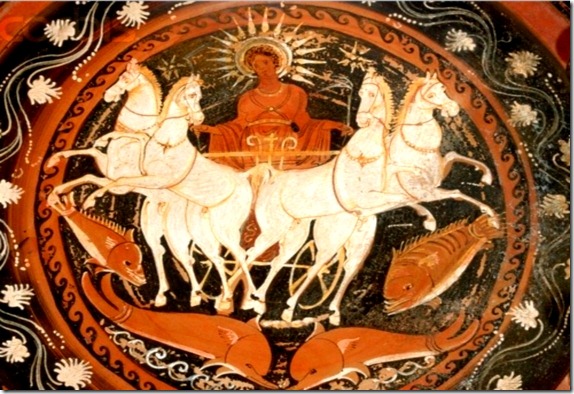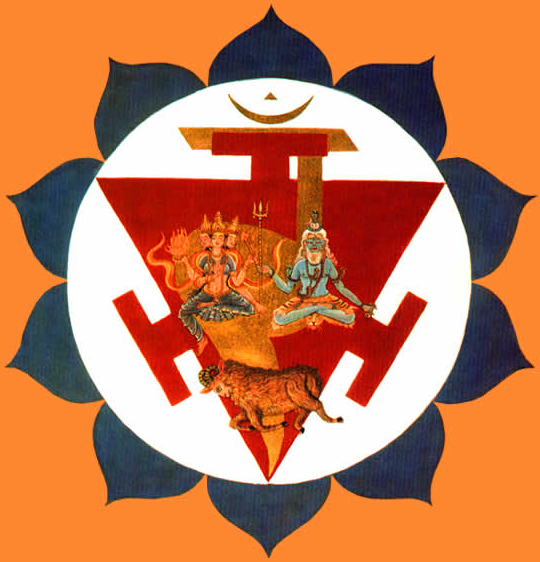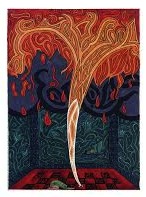In our next Yoga+Art class we’ll explore manipura, or the fire chakra. In looking for inspiration for both the postural and creative components of our class, I went back to pioneering psychologist Carl Jung’s insights into the chakra system and to manipura specifically.
 Contemporary chakra psychology sometimes isolates our study of the chakras (or energetic centers) in order to diagnose and treat specific physiological and psychological imbalances. We also commonly talk about the chakras in terms of material associations: colors, minerals, herbs, foods and in terms of specific physiological, anatomical sites of balance or dysfunction in the gross body. We associate the chakras with specific emotional associations and forces of ego-based personality construction. So that for instance, we talk about manipura as the center of our “will”; where a healthy ego makes that will manifest in the outer world. We associate it with the color yellow, with fire, with digestion and the digestive organs and with disorders in this area, but also with psychological disorders such as aggression, control, manipulation or conversely with low self-esteem or passivity.
Contemporary chakra psychology sometimes isolates our study of the chakras (or energetic centers) in order to diagnose and treat specific physiological and psychological imbalances. We also commonly talk about the chakras in terms of material associations: colors, minerals, herbs, foods and in terms of specific physiological, anatomical sites of balance or dysfunction in the gross body. We associate the chakras with specific emotional associations and forces of ego-based personality construction. So that for instance, we talk about manipura as the center of our “will”; where a healthy ego makes that will manifest in the outer world. We associate it with the color yellow, with fire, with digestion and the digestive organs and with disorders in this area, but also with psychological disorders such as aggression, control, manipulation or conversely with low self-esteem or passivity.
In 1932 Carl Jung gave a series of talks on kundalini yoga (later published as “The Psychology of Kundalini Yoga” by the Bollingen Press). Jung wanted to point out the parallels and shared symbolism between his understanding of Kundalini psychology and his emerging ideas around the psychology of individuation. In that, his emphasis in describing and interpreting Kundalini was in the total movement, both personally and more broadly evolutionary (or socio-cultural) in one direction or the other through the “cakras”; movement from unconsciousness to consciousness (as in traditional kundalini). Our current fixation on the individual chakras as discrete sources of ego-centered neurosis or psychosomatic disorder is a rather later development.
I’ll quote extensively from the text of Jung’s lectures here to give you an idea of the richness of his comparisons and interpretations. (*Notes at the bottom of this post define a couple of terms that might be unfamiliar.)
The Symbolism of Manipura
Talking comparatively, Jung first describes manipura in symbolic terms; in the terms of other mythologies and rituals:
“…And this is the symbolism of all initiation cults: the awakening out of muladhara (root chakra), and the going into the water (svadhisthana/sacral chakra), the baptismal fount with the danger of the makara*, the devouring quality or attribute of the sea.

The Helios, or sun-god
“Then, if you pass through that danger you reach the next center, manipura, which means the fullness of jewels. It is the fire center, really the place where the sun rises. The sun now appears; the first light comes after the baptism. This is like the initiation rites in the Isis mysteries, according to Apuleius, where the initiate at the end of the ceremony was put upon the pedestal and worshiped as the Helios, the deification that always follows the baptismal rite. You are born into a new existence; you are a very different being and have a different name.”
“One sees all that very beautifully in the Catholic rite of baptism when the godfather holds the child and the priest approaches with the burning candle and says: ‘Dono tibi lucem eternam‘ (I give thee the eternal light) – which means, I give you relatedness to the sun, to the God.”
“So manipura is the center of the identification with the god, where one becomes part of the divine substance, having an immortal soul.”
“This is a worldwide and ancient symbolism, not only the Christian baptism and in the initiation in the Isis mysteries. For instance, in the religious symbolism of ancient Egypt, the dead Pharoah goes to the underworld and embarks in the ship of the sun. You see, to approach divinity means the escape from the futility of the personal existence and the achieving of eternal existence, the escape to a nontemporal form of existence. The Pharoah climbs into the sun bark and travels through the night and conquers the serpent, and then rises again with the god, and is riding over the heavens for all eternity.”
“So this third center is rightly called the fullness of jewels. It is the great wealth of the sun, the never-ending abundance of divine power to which man attains through baptism.
 In later chapters of “The Psychology of Kundalini Yoga,” Jung discusses some of the symbolism of the “icons” of manipura (every chakra is represented by a traditional “graphic” including the lotus flower in various forms, a variety of specific animal totems, gods and goddesses, Sanskrit characters indicating seed sounds or mantras, and colors):
In later chapters of “The Psychology of Kundalini Yoga,” Jung discusses some of the symbolism of the “icons” of manipura (every chakra is represented by a traditional “graphic” including the lotus flower in various forms, a variety of specific animal totems, gods and goddesses, Sanskrit characters indicating seed sounds or mantras, and colors):
(From Chapter 2, in reference to the symbolism of manipura, the “3-handled” triangle.)
“I rather think that they are handles of a pot – to the lift the pot – and there is a lid on top which has also a handle. I think that is probably to be explained from the alchemistic aspect, because manipura is the fire region, and that is that kitchen, or the stomach, where the food is cooked. One stuffs the food into the pot, or into the belly, and there it is heated by the blood. In that way food is prepared so that one can digest it.”
“Therefore manipura would be a center in which substances are digested, transformed.”
“In manipura the ram is the symbolic animal, and the ram is the sacred animal of Agni, the god of fire. That is astrological. The ram, Aries, is the domicilium of Mars, the fiery planet of passions, impulsiveness, rashness, violence, and so on. Agni is an apt symbol… It is now a sacrificial animal…but the smaller sacrifice of the passions. That is, to sacrifice the passions is not so terribly expensive…the danger has already diminished…Your own passions are really less a danger than to be drowned in unconsciousness…You have overcome the worst danger when you are aware of your fundamental desires or passions.”
Jung gives us an array of images and symbols drawn both from within and outside the Tantric philosophical system in order to give Westerns and non-practitioners (and strictly speaking with reference to the lectures, other psychoanalysts) a closer understanding of this Eastern system of self-knowledge. He gives us a broader cultural currency with which to understand with more symbolic or imagistic nuance of the overriding “action” of manipura.
The Psychology of Manipura
From here, Jung moves from the symbolic foundation to his psychological understanding of manipura:
“But of course, that is all symbolism. We come now to the psychological interpretation, which is not as easy as the symbolic or comparative method. It is far less easy to understand manipura from a psychological point of view.
(Dr. Reichstein asks: “But is not manipura a symbol of fire, of things burned?”)
“Well, it is not just a destructive symbol, it means more a source of energy. But you are quite right – there is always a note of destruction when one speaks of fire; the mere mention of fire is enough to rouse the idea of destruction. And there you touch upon that fear that causes abstraction; we easily get abstract when we do not want to touch a thing that is too hot.”
“Yes, desire, passions, the whole emotional world breaks loose. Sex, power, and every devil in our nature gets loose when we become acquainted with the unconscious.”
“So it is just that – you get into the world of fire, where things become red-hot. After baptism you get right into hell – that is the enantiodromia*.”
“But what is passion, what are emotions? There is the source of fire, there is the fullness of energy. A man who is not on fire is nothing: he is ridiculous, he is two-dimensional. He must be on fire even if he does make a fool of himself. A flame must burn somewhere, otherwise no light shines; there is no warmth, nothing.”
Jung describes manipura as the center of emotions and passions. But this is “heat” and “fire” without consciousness, or without having arrived yet to the level of “thought” or anahata (heart chakra). Before that, “underneath” that, all is impulse, the fiery heat of feelings, of desires, impulses and passions.

The Opening of the Egg, From Liber Novus/The Red Book, C. G. Jung
From svadhisthana (sacral chakra) – which Jung equates to the unconscious, with its watery, subterranean characteristic – we are cast into the cauldron of manipura. Where creativity, eros “surfaces” into still airless fire, heat. We are not solid, or dry. The cauldron is a container for still-moving, fluid energy. Contained, but not yet formed. In terms of the evolution of the integrated personality, we are still “unconscious” or consumed by our emotions, and still potentially explosive.
For Jung and his understanding of the psychology of manipura, emphasis is on where manipura has to move up, off the surface of the diaphragm/earth to anahata – to air, to thought, to first consciousness. Before anahata, all is still unconscious-ness – instinctual, primitive, naive. Unformed, fluid, murky, churning coming to light in manipura. Here manipura is transitory for Jung (whereas it is often site-specific for a particular transformative experience for chakra psychology). In the process of individuation, we move through, integrate and keep on moving.
“In your consciousness everything is as you have put it, but then you discover that you are not master in your own house, you are not living alone in your own room, and there are spooks about that play havoc with your realities, and that is the end of your monarchy.” – Carl Jung, The Psychology of Kundalini Yoga
The Psycho-physiological Meaning of Manipura
With reference to the physical body, Jung talks about “psychical localizations” and continues to tie them to his understanding of the psychological process of self-understanding:
“Now this third center, the center of emotions, is localized in the plexus solaris, or the center of the abdomen. I have told you that my first discovery about the Kundalini yoga was that these cakras really are concerned with what are called psychical localizations. This center then would be the first psychical localization that is within our conscious psychical experience.”
“The diaphragm would be about the surface of the earth. As long as you are in manipura you are in the terrible heat of the center of the earth, as it were. There is only the fire of passion, of wishes, of illusions.”
“Now, in manipura you have reached an upper layer where there comes a definite change. The bodily localization of this cakra under the diaphragm is the symbol for the peculiar change that now takes place. We understand more or less what manipura means psychologically, but now we have come to great leap, anahata. What follows psychologically after you fallen into hell? When you have come into the whirlpool of passions, of instincts, of desires and so on, what follows after?”
(Mrs. Crowley offers an answer: “Usually an enantodromia; some opposite will now be constellated. Some vision perhaps, or something more impersonal will follow.”)
“An enantodromia, which would be the discovery of something impersonal? In other words, one no longer identifies with one’s desires…The next center, as I told you, has to do with the air. The diaphragm would correspond to the surface of the earth, and apparently in getting into anahata we reach the condition where we are lifted up from the earth. What has happened? How do you get there at all? You see in manipura we still don’t know where we are; we are in muladhara just as well, at least our feet are still standing in muladhara: but in anahata they are lifted above the surface of the earth. Now, what literally could lift one above the the earth?”
(Dr. Meier: “The wind.”)
“Yes, that would be within the symbolism, but there is another thing that would make it a bit plainer.”
(Dr. Bertine: “A sort of distillation?”)
“That is a good idea, which leads us right away into alchemistic symbolism. The alchemist calls this process sublimation. But to remain within the symbolism of which we are speaking today?”
(Mr. Alleman: The sun rises above the horizon.”)
“Yes, you rise above the horizon according to the Egyptian symbolism. If you are identical with the sun, you rise above the horizon with the sun ship and travel over the heavens. The sun is a superior power. If you are an appendix of the Pharoah, the sun can lift you up to almost a divine position. And the contact with the sun in manipura lifts you up off your feet into the sphere above the earth. The wind also can do it, because in primitive beliefs the spirit is a kind of wind.”
“Therefore in many languages there is the same word for wind and spirit, spiritus for instance, and spirare means to blow or breathe. Animus, spirit, comes from the Greek anemos, wind; and pneuma, spirit, is also a Greek word for wind. … The connection between wind and spirit is due to the fact that the spirit was thought originally to be the breath, the air one breathes out or expires. With a person’s last breath his spirit leaves the body. So it would be either a magic wind or the sun that lifts you up.”
“How do you get lifted up above the manipura center, above the world of your mere emotions?
(Mrs. Mehlich: “Is it that one begins to think?”)
“Exactly.”
(Dr. Reichstein: “It is said that here the purusa is born, so it would be here that the first idea of the self is seen more completely.”)
“Yes, you begin to reason, to think, to reflect about things, and so it is the beginning of a sort of contraction or withdrawal from the mere emotional function. Instead of following your impulses wildly, you begin to invent a certain ceremony that allows you to dis-identify yourself from your emotions, or to overcome your emotions actually. You stop yourself in your wild mood and suddenly ask, ‘Why am I behaving like that?'”
What I find particularly illuminating is the movement from diaphragm (the core muscle of respiration) up to anahata, whose element is air, which Jung’s equates with spirit and breath. Here we can begin to focus on the role of breath, the notion of prana as life-force energy, our link to every animate thing in the cosmos. Anahata is where we realize consciousness outside of our own ego and physicality.
I’ll leave you with Jung’s reading of that moment of coming to consciousness, to that awareness that we are or have an ego, but that there is also a simultaneous awareness, if you catch it, that something larger – Self or psyche or purusa – has brought you to this recognition:
“So the crossing over from manipura to anahata is really very difficult. The recognition that the psyche is a self-moving thing, something genuine and not yourself, is exceedingly difficult to see and to admit. For it means that the consciousness which you call yourself is at an end. In your consciousness everything is as you have put it, but then you discover that you are not master in your own house, you are not living alone in your own room, and there are spooks about that play havoc with your realities, and that is the end of your monarchy.”
*Makara (definition) in Hindu mythology a kind of “chimera” or monster that is half terrestrial animal and half sea animal. Roughly equivalent to a leviathan, or “sea monster.”
*Enantodromia (definition) in Jungian psychology an opposing force, presentation or occurrence in individual psychological development or individuation. An excess of one kind of psychological tendency will produce or transform into its opposite.
*Purusa (definition) for the purposes of this brief discussion, a Sanskrit concept roughly equivalent to Jung’s concept of “psyche” or the Self (that limitless existence of self beyond ego).